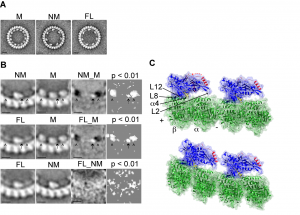Kinesin 13 neck Obstructs Adjacent Binding Site Access on Curved
Kinesin 13 neck Obstructs Adjacent Binding Site Access on Curved
Figure 3 from JCB 185(1):51-57: Kinesin 13 neck Obstructs Adjacent Binding Site Access on Curved alpha/beta-heterodimers. (A) Representative class averages for dolastatin rings decorated with M, NM, and FL. Scale bar represents 100 Angstroms. (B) Representative class averages (M, NM, and FL), difference maps (NM-M, FL-M, and FL-NM), and student’s t-test maps (last column) for motor-heterodimer cut-outs. Arrowheads mark the adjacent binding site on the curved protofilament, and arrows mark the position of extra density seen in NM and FL. Scale bar represents 50 Angstroms. (C) Model of the crystal structures of truncated NM (pdb codes 2HEH and IV8K) fitted onto straight (pdb code 1tub) and bent tubulin (pdb code 1SAO). The region in red corresponds to the neck domain and the dashed arrow indicates the difference in neck orientation between the two crystal structures, the region in yellow is the alpha-relay helix and other important domains are marked.
Mulder, A. M. et al. – Alex Glavis-Bloom, Carolyn A. Moores, Michael Wagenbach, Bridget Carragher, Linda Wordeman, and Ronald A. Milligan


